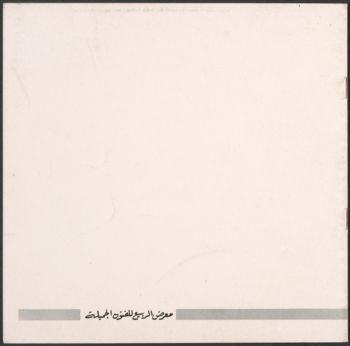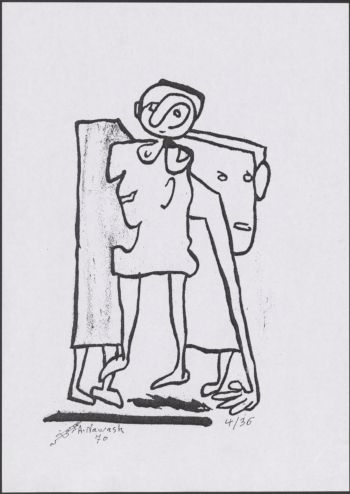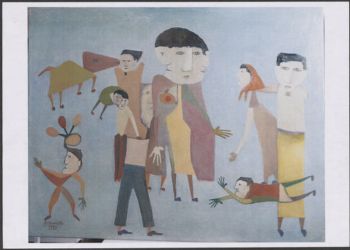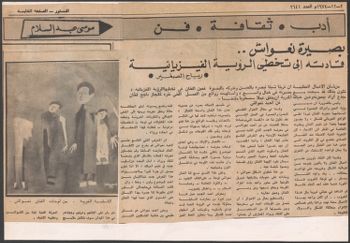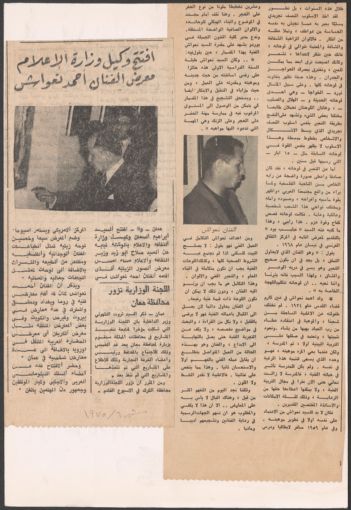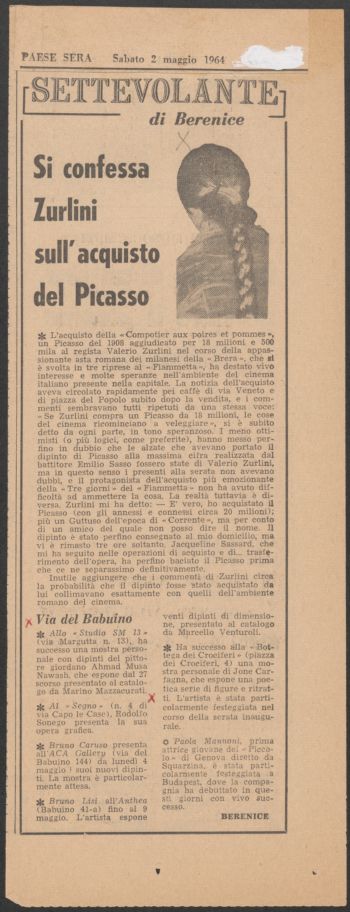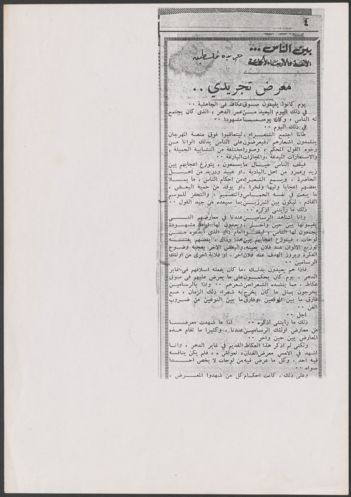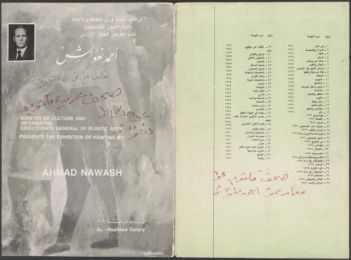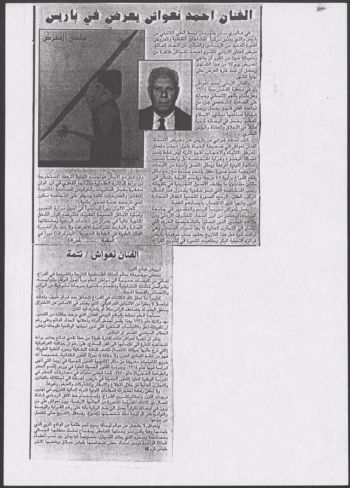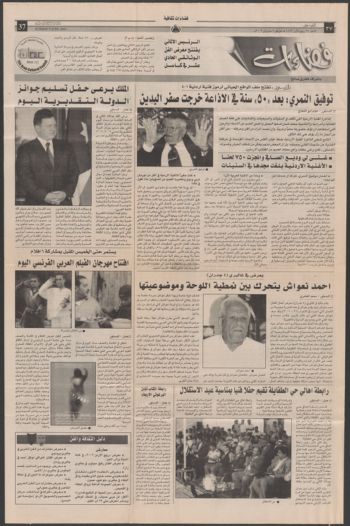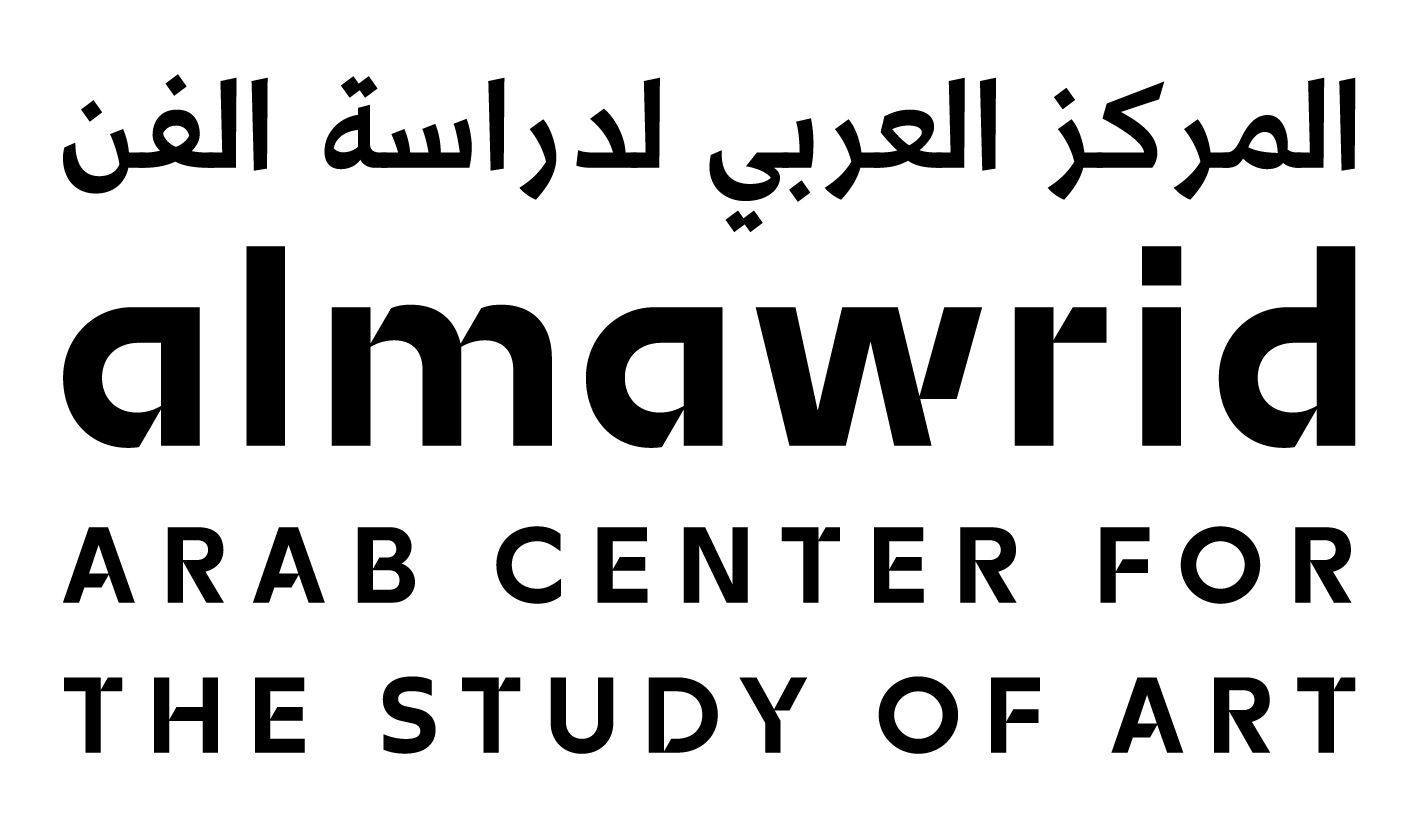Ahmad Nawash Collection
Call Number
Date
Creator
Extent
Physical Description
Language of Materials
Abstract
The collection includes press clippings, exhibition materials, and drawings and sketches reflecting his dedication to documenting Palestinian catastrophes. The collection also includes critiques of the artist's work, documents detailing his education in Italy and France, including certificates, student IDs, and recommendations facilitating his studies. The collection encompasses posters, correspondences with galleries, price lists, and press clippings from exhibitions, specially the ones from Amman that shed light on his engagement with art and culture centers. Notable highlights include photographs of early shows at the University of Jordan, invitations and notes from Baghdad in 1982, as well as color plans and sketches for graphic art. The Italian art curricula, Arabic teaching materials, and academic papers reflect on art education in Jordan during the 1970s-1990s. Ahmad Nawash, born in 1934 near Jerusalem, experienced displacement from his ancestral village in 1948 and settled in Jordan. Despite many challenges, Nawash pursued art,training at the Academy of Fine Arts in Rome completing a bachelor's degree with honors in 1964. As soon as Nawash returned to Amman, he started exhibiting widely and earning recognition. He trained as an art teacher in Amman before receiving a scholarship to further his studies in France. He earned a certificate in lithography and zinc etching from the School of Fine Arts in Bordeaux, France in 1970. Active in the Amman art scene, Nawash taught at universities and received awards for his impactful contributions.
Biographical Note
Ahmad Nawash (1934–2017) was born in Ein Karem, one of the largest Palestinian villages near Al Quds (Jerusalem). His mother passed away when he was seven years old. He was raised by his father and his stepmother, who was his maternal aunt. He was studying at one of the two elementary schools in Ein Karem when, in 1948, Jewish militias attacked the Palestinian towns and villages and forcefully displaced the natives. Nawash, who was 14 years old at the time, left with his father, stepmother, paternal aunt and uncle in the back of a truck to the Palestinian city of Jericho. His family settled there for a few months before relocating to the Jordanian cities of Salt and Marka, then settled in east Amman's Jabal Taj neighborhood. He continued his high school studies while also working as a carpenter. He had three brothers and four sisters. He married his distant cousin in 1966 and continued to live in the same neighborhood before moving to Jabal Hussein around 1985 and to Naʿur in 2003. He had three sons and one daughter. Nawash was drawn into art as a child after painting a portrait of the anti-Crusader hero Saladin. Seeking out training, he landed in a studio of an Italian artist, Armando Prön, resident in the Wadi See area west of Amman. He joined the studio between 1952 and 1953. Prön recognized Nawash's skill and advised him to travel to Italy and pursue professional art training by joining the free classes at the Academy of Fine Arts in Rome in 1960. Nawash thus sponsored his own studies, eventually succeeding in joining the studio of Franco Gentilini at the Academy of Fine Arts in Rome and obtaining a degree with honors in 1964. He used his time in Italy to visit museums, sketch statues and cathedrals, and practice collage, abstraction, cubism and surrealism. He also undertook a self-guided study of anatomy and filled the walls of his room with large sketches. The collection includes photographs of the artist with colleagues and teachers in Italy, images from the early exhibitions he engaged with, press coverage, and study aid materials on graphic art compiled by students from lecturers and teachers' materials.
Nawash returned to Amman after his studies and exhibited his oil paintings in solo exhibitions in Amman, Damascus, and Jerusalem. Meanwhile, he enrolled in the Amman Teachers' College and graduated in the class of 1968-1969. He contributed to the art programs at the French Cultural Center in Amman and managed to secure a scholarship to study in France.
Nawash received a lithography and zinc etching certificate from the School of Fine Arts in Bordeaux, France, 1970. Upon returning to Amman, the artist presented his prints in a series of yearly solo exhibitions at several foreign cultural institutes and the University of Jordan. Nawash later furthered his studies in Paris, working in lithography and zinc etching from 1975 to 1977, and in Florence in 1980, where he also focused on restoring oil paintings. His collection is rich with press clippings that document these phases. During the mid-1990s, Nawash moved to Paris and planned for his family to join him permanently in France. While he was away, his eldest son, Mousa, passed unexpectedly, which prompted Nawash to drop his immigration plan and resettle in Amman. Nawash was a prolific artist, his work was often on exhibit. Nawash had solo exhibitions in Rome, Amman, Jerusalem, Baghdad, Damascus, and Paris. He also presented work in major group exhibitions, including the Kuwait Biennale in 1981, where he was awarded a Golden Medal and Appreciation Certificate, 2nd Egyptian International Print Triennial in 1996, the 6th International Cairo Biennale in 1996, and the 5th Sharjah Biennale, Sharjah in 2001. Nawash played an active role in Jordan's art scene by sharing his knowledge and the experience he gained from his art training , and by teaching art and contributing to the formation of art curricula in schools. Nawash taught art, painting and art history in the Department of Architecture at the University of Jordan in Amman and painting and art education at the Yarmouk University in Irbid. Nawash received the state recognition award from Jordan in 1990 and an appreciation certificate from the International Biennial of Prints and Drawing, Taipei 1993. His artwork primarily focused on the Palestinian tragedies and acts of resistance, with particular emphasis on the aftermath of the 1967 Arab-Israeli War, naming each art piece after an aspect of the Palestinian cause. Major events in this history of struggle against occupation are present in his works collected by museums in the region, including Darat al Funun – the Khalid Shoman Foundation, Jordan National Gallery of Fine Arts, Mathaf Museum of Modern Art, Dalloul Art Foundation, Barjeel Art Foundation, and others.
Ahmad Nawash passed away in Dubai in 2017.
Dirar Nawash (b.1975) is the artist's youngest son. He takes care of artworks and manages their acquisitions and provenance. He was trained as an engineer and works at Emirates Airlines, Dubai.
Arrangement
The collection is arranged in the following series: (I) Correspondence and personal papers; (II) Academic materials; (III) Exhibition materials (IV) Drawings, sketches, artwork, and reproductions (V) Clippings; (VI) Photographs.
Content Description
The Ahmad Nawash (1934–2017) Collection contains personal papers, professional materials, exhibition materials, drawings and sketches, many reflecting a lifelong dedication to documenting Palestinian tragedies. The materials range from certificates obtained during study abroad, in Italy in the 1960s and 1980, and in France in the 1970s, to exhibition ephemera, photographs and press clippings related to Nawash's professional artistic activities from the 1960s until his passing in 2017.
Critical writing about the artist's work, documents pertaining to his studies in Italy and France, including certificates, student IDs, and diplomatic endorsements, are included, as are exhibition materials such as posters, correspondence with galleries and art institutions, price lists, artwork lists, press clippings, artist statements, and exhibition application forms. On the occasion of solo exhibitions, Nawash often produced a publication, such as a poster or a brochure, and kept photographic documentation.
Other notable highlights include sketches for paintings and for graphic art, photographs of early exhibitions at the University of Jordan, invitations and notes from exhibition visitors in Baghdad in 1982, and exhibition materials from Amman that shed light on Nawash's engagement with cultural centers. Other highlights are materials pertaining to the teaching and study of art, including some the Italian course work that Nawash used while studying at the Academy of Fine Arts in Rome. Arabic teaching materials culled from books and studies, and academic papers reflecting the practice of art education in Jordan, 1970s-1990s. The collection includes materials for courses in Arabic language on art, applied arts, published by Institute of Education, UNRWA / UNESCO in the 1970s, as well as academic papers from the time of the artist's teaching at the University of Yarmouk in Irbid (Jordan).
Numerous copies of statements about the artist's work, written by critics, fellow artists, work colleagues, and heads of cultural institutions appear in the collection, some existing in the handwriting of their authors or on original letterhead.
Correspondence between the Egyptian artist, illustrator, and publisher Mohieddine Ellabbad and Nawash regarding the inclusion of Nawash's work in the newspaper supplement (Kitab fi Jarida) is another highlight of the collection.
Subjects
Organizations
People
Topics
Conditions Governing Access
Digital surrogates only are held by the repository. Based on the agreement with the owner, selected digital images will be publicly available on the NYU finding aid portal. Materials not made available online may be consulted in person at al Mawrid, NYUAD. Researchers should contact nyuad.almawrid@nyu.edu to request details or to make an appointment.
Conditions Governing Use
Intellectual property rights for the Ahmad Nawash collection remain with his family represented by Dirar Nawash. al Mawrid Arab Center for the Study of Art does not hold any legal rights over the content of its collections, and therefore cannot grant legal rights to anyone who wishes to publish material. Copyright status has not been determined for all collection items. It is the responsibility of the researcher to clear the rights from the respective copyright holders. All use permissions must be sought from Dirar Nawash, through a request submitted to al Mawrid Arab Center for the Study of Art at nyuad.almawrid@nyu.edu.
Preferred Citation
Title or identification of item, date when known, Ahmad Nawash Collection, ADMC094, item identifier (Ref. number). Arab Art Archive, al Mawrid Arab Center for the Study of Art, New York University Abu Dhabi.
Existence and Location of Originals
Original materials are with Dirar Nawash in Ahmad Nawash's Studio in Naʿur, Amman, Jordan.
Immediate Source of Acquisition
An agreement was signed in 2022 with Dirar Ahmad Nawash, the artist's son, to loan the collection to al Mawrid for digitization. The materials were returned to the owner upon completion of digitization. The materials were digitized at al Mawrid in July 2024, then returned to the owner upon digitization.
Custodial History
Early in his artistic career, Palestinian Jordanian artist and art teacher Ahmad Nawash (1934–2017) collected documents and newspaper clippings; he often photocopied and inscribed notes on the materials that relate to his artistic practice. The documents of Ahmad Nawash are stored in his studio in the 215 sqm basement of his house in Naʿur area south west of Amman, Jordan. The studio spacious apartment with several rooms and a kitchen, was a working place for Nawash. He organized his artworks by storing them in an L-shaped open wall unit. A cabinet with the artist's library sits next to the art pieces in the same room; at the bottom are drawers full of photographs and video tapes, and on the left are cabinets with stacks of exhibition brochures and catalogs. Inside the lower cabinet are copies of magazines, press materials, and teaching materials that Nawash collected as an art instructor or art student. Since the artist passed away in Dubai in 2017, the collection has been in the care of his youngest son Dirar A. Nawash who represents his siblings.
In 2021, al Mawrid researcher visited the late artist's studio, assessed the collection of documents, created the inventory and secured an agreement from his son on loaning the collection to al Mawrid for digitization, cataloging and publishing. The collection arrived at al Mawrid in April 2022, and after digitization returned to its owner in Amman in October 2023.
Bibliography
About this Guide
Processing Information
Processed by researchers and archivists at al Mawrid Arab Center for the Study of Art, including Ala Younis, Ibrahim Mohamed Ali, Dina Taha, Anneka Lenssen, Jonathan Burr, and Jasmine Soliman.
The arrangement of the materials often reflects groupings established by the artist during his lifetime, such as the files Ahmad Nawash assembled for the scholarship or residency applications. Such files include grouped correspondence with certificates from different academies. Educational materials were grouped in paper envelopes or folders, many of which carry a handwritten note from the artist indicating they are very important.
In the case of the press clippings, al Mawrid's researchers organized the loose clippings by decade, from the 1960s to 2000s. Some press clippings are photocopies with notes written by the artist. In a few instances, the artist had assembled the clippings by pasting them on A4 sheets and binding them in plastic folders without chronological order. This order has been maintained (see Series V.A)
The materials also included numerous copies of recommendation letters and statements on Ahmad Nawash's work authored by colleagues in Amman and from directors of foreign cultural centers and embassies, namely French and academics including from faculty at the University of Jordan. Similarly, the artist maintained many copies of his resume, sometimes written by hand, some typed, and some photocopied or reproduced digitally. The researchers removed duplicates but retained examples of the variation of the format and technical layout of the content. Nawash also kept photographs from his early exhibitions, and researchers at al Mawrid identified the locations and dates of these exhibitions from the press coverage that matched the content of the images.
Arab Art Archive finding aids are prepared in both English and Arabic. Researchers seeking to confirm the Arabic spelling of an artist's name are encouraged to consult the Arabic finding aid. In the English-language finding aids, transliterations of Arabic names are guided by al Mawrid policy to use the artist's preferred professional spelling whenever possible. Spellings are checked against artist websites or social media presence (when existent) as well as any available government documents such as a passport or ID. In the case when no such primary documents may be found, spellings are checked with Library of Congress Name Authority File; academic sources such as Modern Art in the Arab World: Primary Documents; Getty Vocabularies / Union List of Artist Names; and in some cases Mathaf Encyclopedia of Modern Art and the Arab World. Al Mawrid Arab Center for the Study of Art maintains an internal Name Standardization Reference List with notes about authoritative sources. Rather than transliterate Arabic-language titles of documents for the purposes of the English-language finding aid, it was decided for consistency and ease to translate Arabic (and all other language) titles into English. Translated titles and phrases are placed inside square brackets.
Repository
Container
Series I: Personal Papers
I.A. Identification and Residency Cards, 1964–1978
Scope and Contents
Library card from Rome, student cards from France, special ID for public employee issued by security department in Jordan, carte de séjour for Ahmad Nawash and Jihad Nawash in France, RATP metro tickets, and an envelope with annotations by the artist.
I.B. Artist Resumes
Scope and Contents
Handwritten and typed curriculum vitae for the artist from different years, some with handwritten notes or additions by the artist. Materials include biographical surveys from the Ministry of Culture in Baghdad (1995) and Ministry of Culture in Amman (2002), and from Sharjah Biennial (2001).
I.C. References for the Artist
Scope and Contents
Typed and handwritten reference letters and statements about the artist authored by different referees including Mahmoud Samra, Princess Wijdan Ali [Al Hashemi], Mohammad Ghani Hikmat, Dr Hani Al Amad, Dr Hashim Yaghi, French cultural attaches and heads of French Cultural Center in Amman (e.g. Pierre Carpenter, Noel Favreliere), Dr Fahmi Jadaane and others. Include drafts and photocopies.
1. Princess Wijdan Ali [Al Hashemi]
2. Dr. Fahmi Jadaane
3. French diplomats in Jordan
4. Dr. Hashim Yaghi
5. Dr. Hani Al Amad
6. Marino Mazzacurati
7. Mohamed Gamal
8. Mahmoud Samra
9. Others
I.D. Artist Annotations
Scope and Contents
Empty folders and envelopes with notes handwritten by the artist.
Series II: Correspondence
II.A. Correspondence and Applications
Scope and Contents
Four binders and one paper folder, organized by the artist. Include letters and applications for visas, residencies and scholarships issued between embassies in Italy, Jordan and France, correspondence with galleries and with Jordanian and international art institutions regarding exhibitions, receipts, testimonies and reference letters, and certificates. They also include entry forms to Tokyo International Mini-Print Triennial 2002, International Print Triennial in Kanagawa 1998, Sharjah Biennale 2001, and others.
II.B. Postcards with Handwritten Notes
Scope and Contents
Postcards with handwritten notes on the back, exchanged with the artist's family and professors between 1964 and 1978.
Series III: Academic Materials
Scope and Contents
Sets of lectures and study materials circulated at Accademia di Belle Arti (Academy of Fine Arts) in Rome between 1963 and 1964, as well as certificates pertaining to the artist's training in Rome and Bordeaux. Sets of art and applied art courses taught in UNRWA schools in the Levant c.1970s. Some academic papers written by the artist's peers on the state of fine arts in Jordan in 2002. The artist kept a copy of a book on abstraction in art, authored by painter Dr Mahmoud Al Bassiouny in 1950.
III.A. Education at Accademia di Belle Arti, Rome
Scope and Contents
Study notes on graphic arts prepared by students, reviewed by professors. Sold to students as supporting study materials. Dated 1963-1964.
III.B. Course Outlines and Syllabi Published by UNRWA / UNESCO
Scope and Contents
Course syllabi on art and applied arts, published between 1973 and 1977. The courses include subjects such as art education in elementary schools, lesson plans on embroidery, ceramics, ornaments, and other crafts.
III.C. Teaching Materials, Yarmouk University, Irbid
Scope and Contents
Teaching statements by the artist, course outlines and educational manuals, related to Ahmad Nawash. Dated 1990–91.
III.D. Plastic Arts Forum in Amman, 2002
Scope and Contents
Sets of academic papers presented in a conference titled [Plastic Arts Forum], organized at the Royal Cultural Center, Amman, Jordan, April 2002. Collected by the artist.
III.E. Academic Certificates
Scope and Contents
Certificates issued by the Academy of Fine Arts in Rome, paper certificates related to the artist training in lithography from the School of Fine Arts in Bordeaux, France, and reference letters related to Nawash's specialization in this field of study.
III.F. Other Educational Materials
Scope and Contents
Includes a scan of a booklet in Arabic by Egyptian painter and art educator Dr. Mahmoud al Bassiouny titled Abstraction in Art, published in Cairo in 1950.
Series IV: Exhibition Materials
IV.A. Exhibition Publications, 1972–2008
Scope and Contents
Brochures, catalogs, and other printed material from exhibitions organized between 1972 and 2008. Venues include the French Cultural Center, American Cultural Center, University of Jordan, Darat al Funun, in Amman, as well as other institutions.
IV.B. Exhibition Posters, 1974–2000
Scope and Contents
Posters for solo exhibitions organized at different institutions between 1974 and 2000. Venues include the French Cultural Center, American Cultural Center, University of Jordan, Darat al Funun, in Amman, and others.
IV.C. Price Lists, 1960s–2000s
Scope and Contents
Handwritten and typed price lists of artworks and other lists of works by the artist in Arabic, English, and French.
IV.D. Guest Books
Scope and Contents
Pages from guest books of exhibitions organized in Baghdad in 1967 and 1982.
IV.E. Certificates, 1975–2007
Scope and Contents
Certificates of appreciation and participation in exhibitions and art festivals, in Iraq, Jordan, and China.
Series V: Drawings, Sketches, Artwork, and Reproductions
V.A. Preparatory Drawings
Scope and Contents
Pencil and ink drawings prepared for color application in Nawash works.
V.B. Drawings, 1964–1975
Scope and Contents
Ink and pencil drawings on paper of different sizes, signed by the artist. Dated 1964, 1965, 1967, 1968, 1969, 1971, 1973, 1975 and 3 undated.
V.C. Sketchbook, 1980
Scope and Contents
Wire bound sketch book with ink drawings, dated 1980.
V.D. Etchings
Scope and Contents
Two etching prints by the artist from 1998, and two etching prints gifted to the artist from 1963 and 1984.
V.E. Other Artwork on Paper
Scope and Contents
Works by Nawash produced as preparatory drawings for design projects.
V.F. Photocopies and Reproductions of Artworks
1. Black and white photocopies of reproductions, between 1970 and 1991 with some undated.
2. Color print-outs and reproductions of artworks, 1967–2006.
Series VI: Press Clippings
Scope and Contents
Clippings collected by the artist and kept loose or in bound volumes, beginning from the 1960s. The materials mainly detail exhibitions in which Nawash participated, taking place in Amman, Baghdad, Jerusalem, Damascus, Paris and Rome. The materials extend into the 2000s.
VI.A. Clippings Compiled and Ordered by the Artist
Scope and Contents
Two portfolios of press clippings and statements about the work of the artist organized in non chronological order.
1. Portfolio 1
Image Set
2. Portfolio 2
Image Set
VI.B. Press Clippings from the 1960s
Scope and Contents
Press materials from the 1960s mainly cover the exhibitions that Ahmad Nawash participated in during his studies in Rome or after his graduation and active return to Amman in the 1960s. Italian publications include Il Nargiso, Il Tempo, Paese Sera, and Il Popolo, while Arabic publications include Al Manar, Addustor, Addifa' and Al Baath.
VI.C. Press Clippings from the 1970s
Scope and Contents
Press materials from the 1970s cover the solo exhibitions that Ahmad Nawash organized at the cultural institutes and the University of Jordan in Amman. Critics write on the number of works, themes and quality of the paintings. Publications include Addustour, Alrai, Al Akhbar, and Al Nahar newspapers. An issue of Afkar magazine from 1974 featured a painting by Nawash titled Circus Performer. Writings are by Ibrahim Najjar, Ayyad Nimer, and Issa Al Jarajerah.
VI.D. Press Clippings from the 1980s
Scope and Contents
Press materials from the 1980s cover Nawash's solo exhibitions at Gallery Alia, French Cultural Center in Amman, Yarmouk University in 1986, and at Al Rasheed Hall in Baghdad organized by the Iraqi Ministry of Culture and Information in 1982. Materials also include profiles and biographies published in Iraqi newspapers such as Al Thawra, Addustour, Al Jumhouriya, and in Jordanian media such as Addustour, The Jordan Times, and The Jerusalem Star. They feature art correspondents such as Rabah Al Saghir, Meg Abu Hamdan, Abdul Raouf Shamoun, and Adnan Yahya.
VI.E. Press Clippings from the 1990s
Scope and Contents
Press materials from the 1990s cover exhibitions by Ahmad Nawash, such as a 1994 solo organized by Darat al Funun at the Abdul Hameed Shoman Foundation hall in Jabal Amman, his 1995 solo at Aba'ad Art Gallery, and a graphic art generational group exhibition at Amman's city hall in 1998. Press clippings published in Jordanian newspapers, including Alrai, Addustour, Al Arab Al Yawm, and Al-Aswaq, include articles on Nawash's work written by several art correspondents and critics, such as Jordanian artist and critic Ghassan Mafadleh for Alrai, and the Syrian artist critic Asaad Arabi for the London-based Al Hayat Newspaper.
VI.F. Press Clippings from the 2000s
Scope and Contents
Press materials from the 1990s cover a talk by Nawash at Darat al Funun in 2000. This and other events and interviews were reported on by Hussein Daaseh, Mohamed Al Ameri, Rasmi Jarrah, among others. They were published in Jordanian media outlets such as Addustour and Alrai.
Series VII: Photographs
Scope and Contents
Series of photographs that document the artist exhibitions in Amman, Rome and Jerusalem from the 1960 to 1987. The photographs show the exhibition halls, the state officials that came to inaugurate the exhibitions as well as the audience engaging with the art on exhibit. Other photographs document Nawash's early years studying in Rome, 1959–64, and photographs taken of his artworks.
VII.A. Exhibition Photographs
Scope and Contents
The series includes printed materials related to Ahmad Nawash exhibitions in Amman, and some are in Rome and Jerusalem.
1. Exhibition in Rome, Italy, 1960
2. Solo exhibition in Italy 1964
3. Solo exhibition in Jerusalem, 1965
4. Solo exhibition at the American Cultural Center, Amman 1965
5. Photographs of exhibitions at the University of Jordan. Circa 1970s
6. Photographs of exhibitions at the American Cultural Center, Amman. Circa 1970s
7. Solo exhibition at the University of Jordan, Amman, 1974
8. Solo exhibition at American Cultural Center, Amman, 1975
9. Solo exhibition at Library of University of Jordan, Amman, 1977
10. Solo exhibition at the French cultural Center, Amman, 1978
11. Solo exhibition at the French Cultural Center, Amman, 1979
12. Exhibitions at the American Cultural Center, Amman, 1970s
13. Solo exhibition at Jordan National Gallery for Fine Arts, 1981
14. Solo exhibition at the French Cultural Center, Amman 1983
15. Solo exhibition at the French Cultural Center, Amman 1987
16. Photographs of exhibitions, n.d.
17. Queen Noor with Nawash at an exhibition opening in Amman, n.d.
VII.B. Photographs of Artworks
Scope and Contents
The series includes photographic prints of artworks by Ahmad Nawash taken in different periods and locations. Some photographs are black and white, and some have the artist's handwriting on the back, indicating the work's title.
VII.C. Personal Photographs
Scope and Contents
Collections of personal photographs of Ahmad Nawash while he studied in Rome in 1959 and in Italian cities such as Pisa circa the early 1980s. The series also includes pictures of the artist in different periods of his life and with fellow teachers graduating from the Amman Teachers' College in 1968-69.
VII.D. Photo Envelopes
Scope and Contents
Plastic and paper envelopes in which Nawsh kept his photographs and noted some information related to the content.
